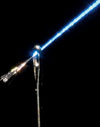New process builds electronic function into optical fibre
19 April 2006
Opto-Electronics
Optical fibre helped bring us the Internet, and silicon/germanium devices brought us microelectronics. Now, researchers have announced that they have developed a new way to combine these technologies.
A joint team from Penn State University and the University of Southampton has made semiconductor devices, including a transistor, inside microstructured optical fibres. The resulting ability to generate and manipulate signals inside optical fibres could have applications in fields as diverse as medicine, computing, and remote sensing devices.
Picture shows a glass fibre with a bundle of semiconductor wires emanating from it. Each wire is just 2 microns in diameter. The glass fibre is glowing from blue laser light
Optical fibre has proved to be the ideal medium for transmitting signals based on light, while crystalline semiconductors are the best way to manipulate electrons. One of the greatest current technological challenges is the rapid and efficient exchange of information between optics and electronics, and this new technique may provide the tools to cross the divide.
"This advance is the basis for a technology that could build a large range of devices inside an optical fibre," said John Badding, associate professor of chemistry at Penn State University. "While the optical fibre transmits data, a semiconductor device allows active manipulation of the light, including generating and detecting, amplifying signals, and controlling wavelengths."
The key breakthrough was the ability to form crystalline semiconductors that nearly fill the entire inside diameter, or pore, of very narrow glass capillaries. These capillaries are optical fibres - long, clear tubes that can carry light signals in many wavelengths simultaneously. When the tube is filled with a crystalline semiconductor (using chemical vapour deposition), such as germanium, the semiconductor forms a wire inside the optical fibre.
The team has built a simple in-fibre transistor, and they point to the success of the Erbium Doped Fiber Amplifier, invented in the late 1980s, to illustrate the transformational possibilities of this technology.
"At present you still have electrical switching at both ends of the optical fibre," says Badding. "If we can get to the point where the signal never leaves the fibre, it will be faster and more efficient. If we can actually generate signals inside a fibre, a whole range of optoelectronic applications become possible."
For more information contact John Badding, Penn State University, [email protected]
Further reading:
Versatile range of camera modules
EBV Electrolink
Opto-Electronics
The CAM-66GY pro-modules from ST are a full range of sample camera modules made for a seamless evaluation and integration of the VD66GY 1,5-megapixel colour image sensor.
Read more...
Enhanced breaker status and communication module
Schneider Electric South Africa
Opto-Electronics
Schneider Electric has announced the launch of its new Breaker Status and Communication Module (BSCM) Modbus SL/ULP, which delivers enhanced performance, improved connectivity, and simplified integration for power distribution systems.
Read more...
Heat-resistant LEDs
Opto-Electronics
Würth Elektronik’s new RGB LEDs are characterised by excellent heat resistance with an insensitivity to temperatures from -40 to 100°C making them ideal solutions for reliable, colour-variable lighting in applications at high operating temperatures.
Read more...
PhotoMOS relays
Future Electronics
Opto-Electronics
The AQY221R2SX and AQY221R2S PhotoMOS from Panasonic Industry ensures excellent characteristics and high-speed switching performance.
Read more...
Mouser now shipping onsemi’s image sensors
TRX Electronics
Opto-Electronics
The AR0145CS is a 1/4,3-inch CMOS digital image sensor with a 1280 (H) x 800 (V) active-pixel array that can capture both continuous video and single frames.
Read more...
Adaptive optics’ power solution
Altron Arrow
Opto-Electronics
Vicor power-dense adaptive optical modules enable colossal telescopes to look into the past for deep space discoveries.
Read more...
Ultra-high speed photo detection
Opto-Electronics
TDK Corporation has announced a photo-spintronic conversion element combining optical, electronic, and magnetic elements that can respond at an ultra-high speed of 20 picoseconds.
Read more...
High-speed lasers
RFiber Solutions
Opto-Electronics
Macom are a high-volume manufacturer of lasers, deploying more than 100 million devices with a reliability of less than 50 FIT and greater than 100 years of wear-out lifetime
Read more...
High-performance optical interconnect
Opto-Electronics
STMicroelectronics has unveiled its next generation of proprietary technologies for higher-performing optical interconnect in datacentres and AI clusters.
Read more...
Halo mid-board optical transceiver
Spectrum Concepts
Opto-Electronics
The Samtec Halo mid-board transceiver has been designed for next-generation embedded applications that require 56 and 112 Gbps PAM4 performance in low profile and ruggedised form factors.
Read more...


